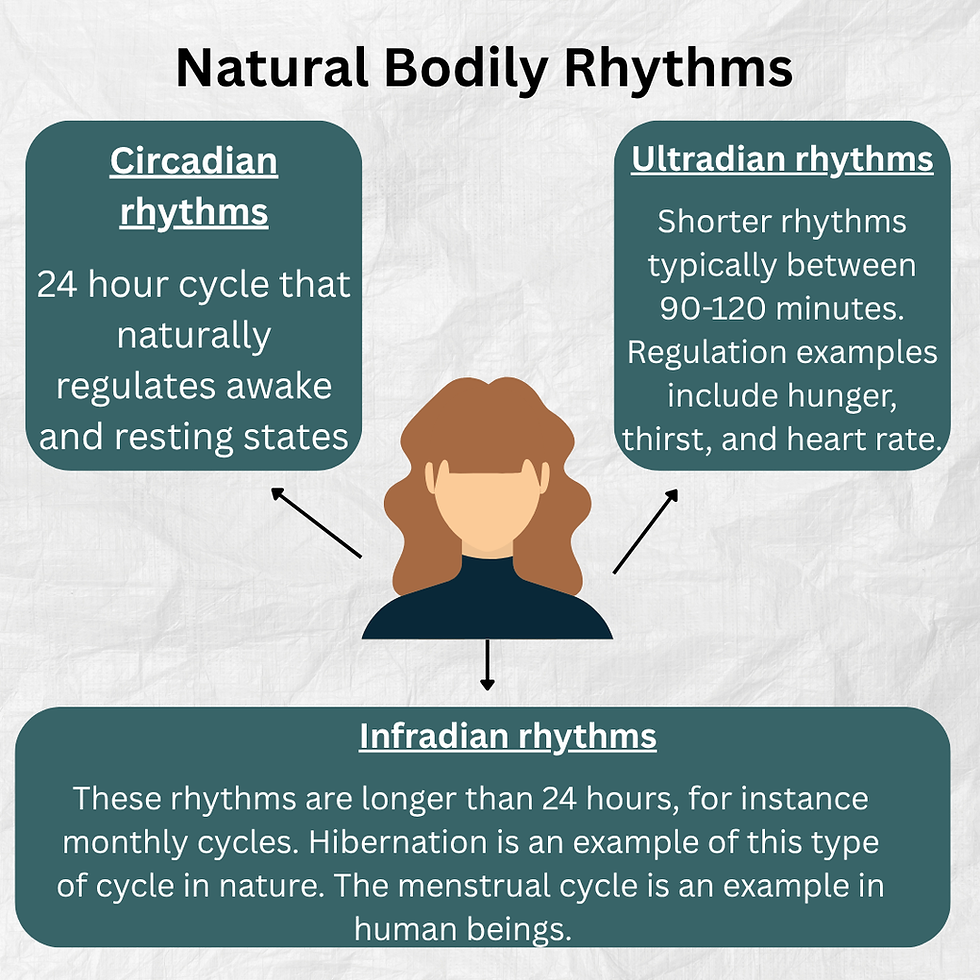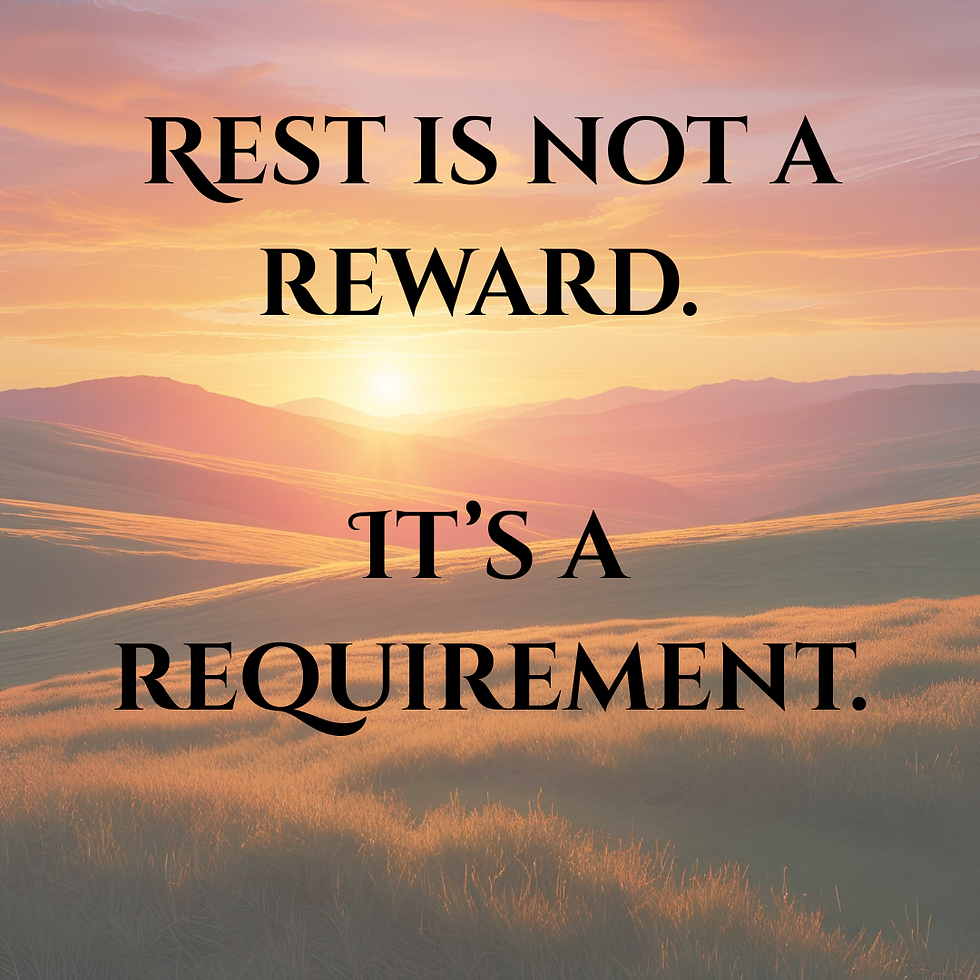Synchronizing Your Time and Energy to Support Your Well-being
- kyliet303
- Jun 30
- 9 min read
Over the past few weeks, we’ve explored two essential forces shaping our well-being: where our energy is going and how we’re using our time. In the energy audit, we looked at how emotional, mental, and physical bandwidth influence our ability to feel grounded, present, and healthy. Then, in last week’s theme, we dove into the idea of time as a wellness tool — not just something to manage, but something to align with intention.

This week, we’re bringing those two threads together.
Time and energy are often spoken about separately, but they’re deeply intertwined in real life. Most of us know this intuitively, but we were never given a blueprint for how to actually use them together. It’s rarely made clear that everything we dedicate time to changes our energy, and how we manage our energy directly shapes how we experience time.
Many of us were raised to be worker bees, indoctrinated into what we now call hustle culture. We were taught to glamorize the grind and believe that nonstop productivity would lead to success, love, and acceptance, and that rest, peace, and freedom were rewards we’d earn someday... maybe in retirement. If you ask me, that’s complete garbage. My dream life doesn’t involve burning out my adrenals, pushing my nervous system to its breaking point, and ignoring the signals of my body on a daily basis to hopefully rest later. I’ll pass on the fast track to chronic stress, soul fatigue, and disempowerment.
But I didn’t always see things this way.
This shift came through the slow, steady work of rebuilding my life from the inside out. During the early years of my wellness journey, as I committed to deep self-development work, I became more aware than ever of how I was using my time and where my energy was going. I could finally see how my new choices — and the ones I had let go of — were either fueling me or draining me. That’s when it clicked: time and energy are my currency in this life. And how I spend them matters.
This week, let’s explore how syncing these two powerful forces, your time and your energy, creates the foundation for sustainable well-being.
Scientific + Psychological Insights: Why Alignment Matters
When most people think about time management, they think in terms of hours, checklists, and calendars. But true productivity — the kind that supports health instead of depleting it — requires understanding the role of energy. Your energy isn’t just a feeling; it’s biological, psychological, and influenced by both internal rhythms and external demands.
🧠 Your Brain Runs on Energy, Not Just Time
Cognitive function is directly tied to your mental energy reserves. When you’re fatigued, your brain enters energy-saving modes. Taking on too much or the wrong type of things when in this state leads to decision fatigue, memory lapses, poor emotional regulation, and increased impulsivity. Studies have shown that your ability to make high-quality decisions actually deteriorates when you’ve been using your brain for too long without rest, even if you technically “have time.”
Translation: You can still have hours left in your day, but your capacity to use them well may already be gone.
⏰ Time Feels Different Depending on Your Energy
Ever noticed how time flies when you’re energized and focused, but drags when you’re mentally or emotionally drained? That’s not just in your head; it’s your perception of time being shaped by your internal state and response to the external environment. When your energy is low, your nervous system is more likely to shift into stress or survival mode, often making you feel more overwhelmed or rushed, which alters how you experience time.
🌿 Your Body Has Natural Energy Rhythms
Your body follows circadian, ultradian, and even infradian rhythms (like your menstrual cycle). These rhythms influence everything from alertness and coordination to hormone
release, digestion, and immune function.

Circadian rhythms (24-hour cycles) affect when you’re naturally more alert or tired.
Ultradian rhythms (90–120 minute cycles) affect your ability to focus and perform.
Infradian rhythms (monthly cycles) impact mood, energy, and capacity, especially in menstruating individuals.
Ignoring these rhythms leads to pushing when you should be resting, and trying to “push through” actually backfires, contributing to chronic stress, burnout, hormonal imbalances, and cognitive exhaustion.
😰 Chronic Overextension Fuels Dysregulation
When you constantly override your body’s need for rest or force your energy into a schedule that doesn’t support it, you begin to shift into chronic dysregulation. This impacts your nervous system, immune system, and emotional well-being. Over time, this kind of misalignment contributes to:
Increased cortisol and stress response
Mood swings, anxiety, or burnout
Suppressed immune function
Poor sleep quality
Hormonal imbalances
✅ Alignment = Efficient, Sustainable, and Supportive
When your time and energy are in sync, you move through your day with more ease and clarity. You’re able to:
Make decisions without feeling overwhelmed
Complete tasks in less time with better focus
Honor your body’s signals while still being productive
Build momentum from small wins instead of burning out from big pushes
Practical Integration: Aligning Time and Energy in Real Life
So, how do you actually start syncing your time and energy? The answer isn’t a one-size-fits-all routine; it’s about learning to listen to your body, observe your patterns, and build flexible structures that support your life, not override it.
Here are some of the ways I’ve personally learned to do this, and how you can begin exploring what works for you:
🔁 A. Rhythm Over Rigid Routine: Flexible Structure with Intention
For a long time, I tried to fit myself into strict daily routines, wake up at this time, do this task next, and complete this by noon. But it didn’t work. It drained me, and I felt boxed in.
What did work was building a rhythm-based system — where I know what needs to get done each week, but I flow through it based on what aligns with my energy that day.
I always get my most critical tasks done first, prioritizing those before anything else. However, for non-critical tasks, I give myself flexibility on when to do them.
Tasks are assigned to the week, not just the day. This gives me space to move things around that aren’t urgent and meet myself where I am at in the moment. The only “rule” I have is that everything assigned to the week must be completed by Saturday.
This approach keeps me focused without making me feel trapped. It also honors my natural ebbs and flows.
🌕 B. Knowing My Patterns: Cycle Tracking + Emotional Awareness
Over time, I’ve learned how much my menstrual cycle (and the moon phases) and even ADHD affect how I show up, not just physically, but emotionally and mentally.
For anyone who menstruates, you can monitor your energy level shifts based on your cycle, as our hormonal changes influence them. Typically, lower energy levels occur a few days before and a few days into your period as your levels of estrogen are reduced, and progesterone is peaking. As your estrogen levels begin to increase, while progesterone levels decrease, during your period, your energy levels increase. Energy peaks in the weeks after your period, through ovulation, as estrogen reaches peak levels and progesterone is lower.
I menstruate with the new moon, and I tend to have lower energy during that time. I know that during these times, a packed social calendar, back-to-back tasks, and starting new projects are significantly harder. I aim to keep my schedule relaxed, focus on only my consistent weekly work & personal life rhythms (no extras), and give myself room to do deep internal reflection.
Around the full moon, my energy naturally peaks; that’s when I’m most social, productive, and inspired. This is where I aim to fill up my social calendar more, will tackle extra tasks, and explore starting new projects.
I’ve learned to differentiate between resistance to starting and transitioning tasks (a common challenge for us ADHD peeps, but something I can regulate and work through) vs. true depletion (a sign to rest or shift gears).
This self-awareness has been a game changer. It helps me avoid forcing myself into tasks that aren't a good fit for my state, and lets me show up more fully when the timing is right.
🍲 C. Everyday Systems That Support Energy Flow
It’s not just about mindset; the way I organize my life physically matters, too.
I meal prep ingredients instead of full meals so I can build meals that suit my mood and needs.
I schedule workouts, but I stay flexible about what kind of movement I do — strength, walking, stretching, or rest.
I prioritize morning sunlight and daily walks as non-negotiable resets for my nervous system.
I have daily tasks and weekly cleaning rhythms that keep my external environment and living space functional
These small shifts keep my energy more stable and help prevent that “crash and scramble” cycle I used to fall into.
😴 D. Rest Is the Foundation, Not the Reward

I no longer treat rest as something I have to earn. It’s built into how I live.
Full nights of sleep are non-negotiable.
I listen to my body — if I’m feeling off, I’ll rearrange my schedule or cancel plans.
I avoid screen time when I’m depleted and turn to grounding practices like nature walks, journaling, or doing nothing at all.
This took time to learn. At first, I felt guilty resting, but over time, I saw how it made me more effective, creative, and regulated in everything else.
Empowering Mindset Shifts: Redefining Productivity and Worth
We live in a world that praises hustle and labels rest as laziness. A world where our value is often measured by our output. It’s no wonder so many of us feel guilty for resting or taking time to care for ourselves, even when our bodies are begging for it.
But here's the truth: your worth is not tied to how much you do.
💡 Rest Is Not a Reward — It’s a Requirement
One of the biggest mindset shifts I’ve made is understanding that rest is not something you earn. It’s something you need in order to function, physically, emotionally, mentally, and spiritually.
Rest improves cognitive function, stress regulation, and immune health.
It allows the nervous system to shift from survival mode into restoration.
It’s the foundation of aligned productivity, not the opposite of it.
When I began honoring rest before burnout hit, everything changed. I became more focused, more creative, and more present. I realized that taking time to recharge wasn’t slowing me down; it was actually setting me up to move through life more sustainably and intentionally.
⚠️ Beware the “Shoulds”
Whenever I catch myself saying, “I should be doing this,” I pause.
That phrase is usually a red flag; a sign that I’m pushing from obligation rather than alignment. It often means I’m trying to override my needs to meet some external expectation or internalized belief about what makes me “enough.”
Now I ask myself a different question:
“Is this aligned with my energy, or am I trying to force it?”
When the answer is force, I pivot. That pivot might mean a walk, a breath, a short rest, or choosing a different task, one that flows more naturally in that moment. The result? Less resistance, more momentum.
🔄 From Earning to Embodying Worth
Many people — myself included — have been conditioned to believe we must earn our rest, our joy, our self-care. But this belief keeps us trapped in cycles of overextension, burnout, and emotional detachment.
I’ve learned that rest isn’t just a break from doing; it’s an embodiment of worthiness.
It's saying “I matter” without needing a checklist to prove it.
It’s recognizing that I show up more powerfully when I’m nourished, not depleted.
It’s reclaiming my time and energy as sacred resources that deserve protection.
When you stop performing for your worth and start protecting your energy, you begin to rebuild your life around what feels good and supports you, instead of what you’ve been told you have to endure.
Conclusion: A New Way to Value Your Life Force
Time and energy are two of your most valuable resources, but they’re more than tools for getting things done. They are extensions of your life force. When you begin syncing them, even in small ways, you stop living in survival mode and start living in alignment.
This isn’t about perfection or control. It’s about becoming aware. It’s about asking yourself:
What is fueling me, and what is draining me?
Is how I’m spending my time honoring the energy I have?
Am I building a life that supports me, or one I have to recover from?
These questions aren’t just reflections, they’re gateways to transformation.
Start where you are. Begin with one small shift this week. Maybe that’s allowing yourself to rest without guilt. Maybe it’s moving a task to a different day because your energy says “not right now.” Maybe it’s noticing when the “shoulds” creep in and choosing curiosity over self-judgment.
You don’t have to overhaul everything overnight. But the more you align your time with your energy, the more your life will begin to feel like yours.



Comments